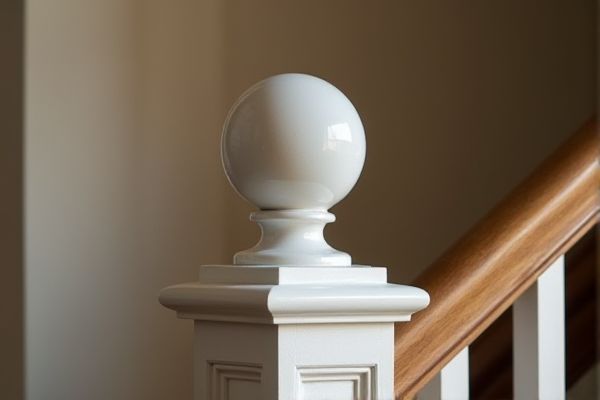
A newel cap is a flat, decorative piece that sits atop a staircase newel post, offering a clean and modern finish, while a finial is often more ornate and sculptural, serving as a distinctive decorative element that adds elegance and style to the post. Explore our detailed comparison to help you decide which option best complements Your staircase design.
Table of Comparison
| Feature | Newel Cap | Finial |
|---|---|---|
| Definition | Decorative top piece that caps a newel post. | Ornamental end piece, often pointed, used on newel posts or furniture. |
| Purpose | Provides a finished look and protection for the newel post. | Adds detailed ornamentation and style emphasis. |
| Design | Simple or decorative flat or rounded shapes. | Intricate, sculpted shapes, often floral or pointed motifs. |
| Material | Wood, metal, or composite materials. | Wood, brass, bronze, or other decorative materials. |
| Location | Placed directly on top of newel posts in staircases. | Installed on newel posts, furniture, or architectural elements' ends. |
| Functionality | Primarily structural finish and minimal decoration. | Primarily decorative and artistic enhancement. |
Introduction to Newel Caps and Finials
Newel caps and finials are decorative elements that enhance the appearance of staircase newel posts by adding style and personality. Newel caps typically provide a flat or slightly rounded finish atop the post, while finials are more ornate, often featuring intricate designs or sculptural details. Understanding the distinction between newel caps and finials helps you choose the perfect topping to complement your staircase's architectural style.
What is a Newel Cap?
A newel cap is a decorative top piece that sits on the newel post, the main supporting pillar at the base or turn of a staircase. It serves both aesthetic and protective functions by enhancing the visual appeal of your staircase while preventing damage to the top of the newel post. Newel caps come in various materials like wood, metal, or glass, allowing customization to suit your interior design.
What is a Finial?
A finial is a decorative ornament often placed at the top of a newel post, staircase, or furniture piece, serving both aesthetic and functional purposes. Unlike a newel cap, which primarily covers and protects the top of the newel post, a finial adds an intricate design element that can range from simple shapes to elaborate carvings or metalwork. Your choice between a newel cap and a finial depends on whether you prefer a minimalist finish or a statement piece to enhance your staircase's visual appeal.
Key Differences Between Newel Caps and Finials
Newel caps and finials both serve as decorative elements atop newel posts, but newel caps are designed as flat or slightly rounded coverings that protect and finish the post, while finials are more ornate, three-dimensional sculptures or shapes that add a distinct architectural flair. The primary difference lies in their form and function: newel caps provide a simple, protective finish, whereas finials emphasize elaborate aesthetics to enhance staircase design. Understanding these key differences helps you select the appropriate detail to complement your interior style and staircase structure.
Design and Style Options
Newel caps offer sleek, minimalist design options that seamlessly blend with modern and contemporary staircases, featuring smooth finishes and understated shapes. Finials provide more ornate and decorative styles, often incorporating intricate carvings, traditional motifs, and varied materials like brass or glass to enhance classic or Victorian stair designs. Both serve as focal points at the top of newel posts but differ significantly in aesthetic impact and customization versatility.
Installation Methods for Newel Caps and Finials
Newel caps install by fitting over the top of a newel post, often secured with adhesive or small nails to ensure stability and a clean finish. Finials typically screw into a pre-drilled hole at the post's apex, offering easy installation and secure attachment. Both require precise measurements for proper alignment, but finials often demand less preparation due to their threaded design.
Material Choices: Wood, Metal, and More
Newel caps and finials come in diverse material choices, including wood, metal, and resin, each offering unique durability and aesthetic appeal. Wooden options provide a classic, warm look that complements traditional staircases, while metal varieties--such as brass, iron, or stainless steel--deliver a sleek, modern finish with enhanced longevity. Your selection of material influences both the overall style and maintenance requirements of your stairway accents.
Durability and Maintenance Comparison
Newel caps typically offer greater durability due to their solid construction from hardwoods or metal alloys, making them resistant to wear and impact over time. Finials, often crafted from more delicate materials like glass or carved wood, may require more frequent maintenance to prevent damage or deterioration from environmental factors. Choosing a newel cap can reduce long-term upkeep costs, while finials may need regular cleaning and occasional repairs to maintain aesthetic appeal.
Cost Considerations: Newel Caps vs Finials
Newel caps generally offer a more cost-effective option compared to finials, as they are simpler in design and require less material and craftsmanship. Finials, often intricately detailed and made from premium materials like brass or carved wood, tend to increase the overall expense of staircase hardware. For budget-conscious projects, newel caps provide an attractive yet affordable finishing touch to stair posts.
Choosing the Right Option for Your Staircase
Selecting the right option for your staircase often depends on style preferences and architectural design; newel caps provide a sleek, modern finish that fits minimalist or contemporary aesthetics, while finials offer ornamental detail suited for traditional or classic interiors. Consider the size and shape of your newel post, as newel caps typically fit flush and highlight clean lines, whereas finials extend upward to create visual interest as a decorative focal point. Material choice and maintenance requirements also influence durability and long-term appeal, with metal or wood options available to complement your overall stair design.
 homyna.com
homyna.com